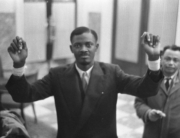![]() From the start, Inside Llewyn Davis seduces, opening with Llewyn Davis (Oscar Isaac) performing a gig at the Gaslight in New York’s Greenwich Village, the focal point of the folk scene in 1961. His soulful voice and sparing full rendition of “Hang Me, Oh Hang Me” is a captivating revelation.
From the start, Inside Llewyn Davis seduces, opening with Llewyn Davis (Oscar Isaac) performing a gig at the Gaslight in New York’s Greenwich Village, the focal point of the folk scene in 1961. His soulful voice and sparing full rendition of “Hang Me, Oh Hang Me” is a captivating revelation.
At a crossroads in his life and career after the suicide of his musical partner, Llewyn struggles to establish himself as a solo act. Leaving the Gaslight stage, Llewyn is informed that a man awaits him outside. In the alley, a wiry man in black discards his cigarette, approaches, and punches Llewyn in mouth.
After the physical beating Llewyn takes a psychic beating. Homeless and living hand-to-mouth, Llewyn wakes up on the sofa of his uptown friends, Mitch (Ethan Philips) and Lillian Gorfein (Robin Bartlett). As he stumbles out of their apartment in the morning, the Gorfeins’ adored cat escapes as the door slams shut behind him. Locked out, Llewyn tramps through the bitterly cold Manhattan streets with his only possessions—a guitar, a bag, and the unwanted cat—over to his best friend Jim’s (Justin Timberlake) Village apartment. However, Jim’s girlfriend and singing partner, Jean (Carey Mulligan), with whom Llewyn has had a volatile, love-hate relationship, has given the couch to a young soldier in town playing a gig, and she will deliver another blow that forces his hand.
Llewyn, desperate for cash and with favors exhausted and options running out, struggles to keep his dreams alive, so he endures a surreal journey with his adopted cat and pompous jazz musician Roland Turner (John Goodman) to audition for a legendary music producer out in Chicago. This odyssey could be his last shot or another fork in the road.
Shot on film on location in New York with the music performed live during the shoot, the Coens recreate the folk scene right before commercial success and big money arrived. Drawing inspiration from the cover of The Freewheelin’ Bob Dylan Album, parodied in the film’s poster, cinematographer Bruno Delbonnel reflects the period and Llewyn’s emotional state with a desaturated, contrasting look and wide-eyed shots, rather than the stylized, almost hyperrealistic designs of the Coens’ previous productions.
The sense of authenticity is reflected in the Coens casting of the sustained musical performances by Isaac, Timberlake, and Mulligan that distinguish the use of music in Llewyn Davis from O Brother, Where Art Thou? Oscar Isaac, an accomplished singer and musician, manages to make Llewyn’s self-destructive arrogance sympathetic. After their previous appearance in Nicolas Winding Refn’s Drive, Isaac reunites with Mulligan, who is cast against type as the unsympathetic Jean whose sweet exterior hides bitter resentment and an acid tongue. In a series of blistering scenes between Jean and Llewyn, Mulligan describes Llewyn as “King Midas’s idiot brother” and tells him, “I should have had you wear double condoms…You should be wearing condom on condom, and then wrap it in electrical tape.”
Executive music producer T Bone Burnett performed in Bob Dylan’s Rolling Thunder tour and produced records for the likes of Roy Orbison, Elvis Costello, Elton John, and Tony Bennett. Mulligan’s husband, Marcus Mumford, is associate producer. The soundtrack album features Mumford, the Punch Brothers, and 12 recordings made especially for the film plus an existing recording by Dave Van Ronk, an oft-overlooked folk figure that Llewyn is loosely based upon. In the tradition of O Brother, which introduced a younger generation to America’s blue grass and country music traditions, Inside Llewyn Davis’s fantastic music transports us to the folk music revival of the late 1950s and early ’60s.
The Coens navigate a simple story of unavoidable failure with realistic characters, a shifting tone, and visual humor. Inside Llewyn Davis is a beautiful love letter to an era and all the wasted promise, missed opportunities, and unsung musical genius eclipsed by the later innovators that they inspired.







Leave A Comment